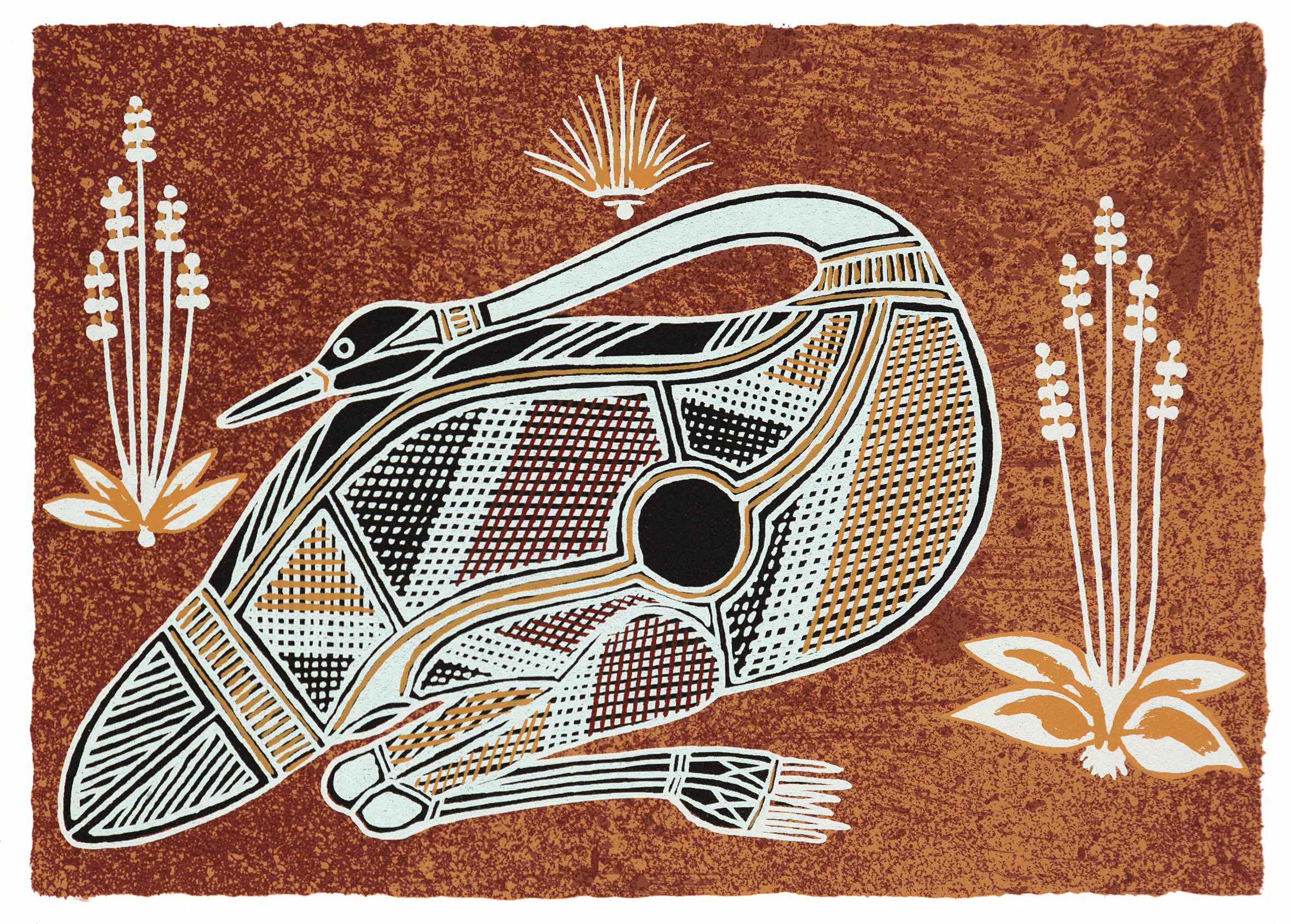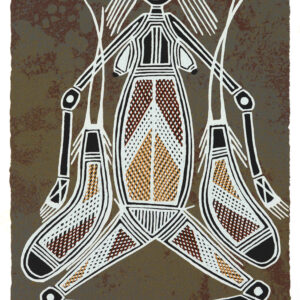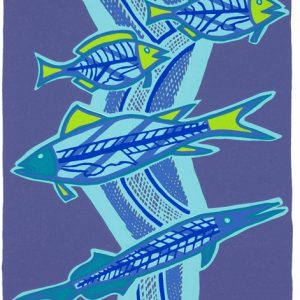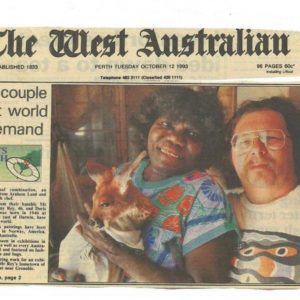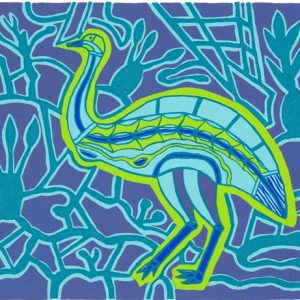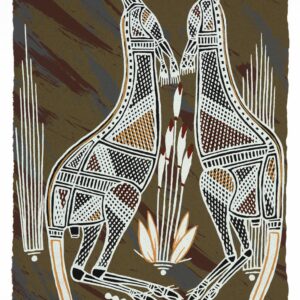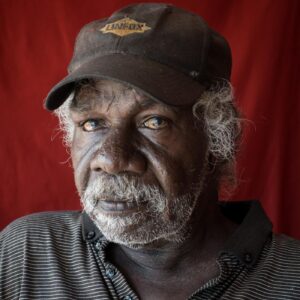Description
- Artist: Graham Badari
- Language group: Kunwinjku
- Moiety: Duwa
- Clan: Wardjak
- Born: 1963
- Screenprint – Edition of 250
- Size of image 16 x 23 cm
- Size of paper 25 x 35 cm
- Size of print with mat board and foamcore backing 28 x 38 cm
There is a Bush Turkey Dreaming site to the west of Gunbalanya, where the Two Dogs came from. The place is called Benukkadjang, which means Bush Turkey Dreaming. The Two Dogs came over eastward from there, looking for water. They found some water and drank it, and they named the place Duruk Benengadbom, which means “two dogs dug a well”.
Kunwinjku art is part of the oldest continuous art tradition in the world. Ancestors of today’s artists have been painting the rock walls of West Arnhem Land for tens of thousands of years. The traditional palette of white, red, yellow and black comes from the ochre that naturally occurs in the region, although contemporary artists sometimes choose to paint in acrylics as well. Kunwinjku artists famously paint using either the traditional rarrk hatching technique, or the more contemporary and complex cross hatching technique which has been adapted from ceremonial painting. These lines are painted using a manyilk, which is a piece of sedge grass shaved down until only a few fibres remain.
Provenance: John Clark commissioned a set of 10 “Oenpelli Prints” in collaboration with Injalak Arts in 1999. The prints feature a range of classic themes.
Biography
Graham Badari’s country is Maburrinj, in the rocky escarpment country about 120 kilometres east of Gunbalanya. He draws artistic inspiration from this environment and also paints the Djang (Dreamings) of his Mother Country, Djurlka, where he spent time as a young man near the outstation of Marmardawerre. He was raised by the renowned artist Djawida Nadjongorle, but like many of the artists at Gunbalanya credits the late Thompson Yulidjirri as his greatest artistic influence. From these senior men, Badari learnt the fluid and dynamic figurative style that defines Kunwinjku painting at Injalak Arts. He began painting sporadically around 1990, but has since become part of a group of dedicated and innovative artists at Gunbalanya. His paintings show the influence of the visual language of their rock-art heritage, while remaining committed to artistic innovation. It is this beguiling balance of tensions, innovation and tradition, ancient and modern, beauty and terror, that energises Badari’s paintings.
Group exhibitions
- 2020 The Alice Prize 2020, Araluen Cultural Precinct, Alice Springs
- 2017 Mayhmayh -Different Birds, Works on paper, bark Nomad Art Gallery, Darwin
- 2016 32nd National Aboriginal and Torres Strait Islander Art Awards, Museum and Art Gallery of the Northern Territory
- 2016 Kunwinkju Counting Book Exhibition and Launch, Nomad Art Galley, Darwin
- 2015 Wearables, Tactile Arts Gallery, Darwin
- 2015 31st National Aboriginal Torres Strait Islander Art Awards, Museum and Art Gallery of the Northern Territory Darwin
- 2015 Dolobbo Injalak bark exhibition, Aboriginal and Pacific Art, Gabriella Roy
- 2013 Wurrkabal, Netanya Resort, Noosa QLD
- 2013 Injalak Arts Exhibition, Better World Arts, Port Adelaide
- 2011 Graham Badari & Gershom Garlngarr AWARDS
- 2010 First solo exhibition, Mossenson Perth
- 2010 Darwin Smith St Public Art project Kuluban installation
- 2009 Menagerie, Object Gallery and Australia Museum
- 2008 Sex, Spirits & Sorcery, The Mossenson Galleries, Melbourne
- 2008 Finalist 25th National Aboriginal Torres Strait Islander Art Awards, Museum and Art Gallery of the Northern Territory Darwin
- 2008 25th National Abiriginal Torres Strait Islander Art Awards, Museum and Art Gallery of the Nothern Territory, Darwin
- 2008 Finalist 25th National Aboriginal Torres Strait Islander Art Awards, Museum and Art Gallery of the Northern Territory Darwin
- 2008 Finalist 25th National Aboriginal Torres Strait Islander Art Awards, Museum and Art Gallery of the Northern Territory Darwin
- 2007 Ngadirriwilkne To Make A Mark, Port Jackson Press Melbourne
- 2007 Lines & Ochre, Ochre Gallery Melbourne
- 2007 Ochre Paintings from Western Arnhem Land, Batchelor Institute Coomalie NT
- 2007 The Injalak Hill Suite, Abiriginal & Pacific Art Gallery Danks St,Sydney
- 2006 Paper, Bark, Canvas & Twine, Dickerson Gallery Melbourne
- 2006 Finalist, 24th National Aboriginal & Torres Strait Islander Art Awards, Museum and Art Gallery of the Northern Territory Darwin
- 2006 Finalist, 24th National Aboriginal & Torres Strait Islander Art Awards, Museum and Art Gallery of the Northern Territory Darwin
- 2006 24th National Aboriginal and Torres Strait Islander Art Awards, Museum and Art Gallery of the Northern Territory Darwin
- 2006 Inspired by Injalak, Port Jackson Press Melbourne
- 2006 2nd Peter Bailie Acquisitive Award, Flinders University, Adelaide
- 2005 Concord, Framed Gallery, Darwin
- 2005 Art of the Stone Country, Entertainment Centre, Darwin
- 1998 Meerzigt, Zoetermeer, The Netherlands
- 1995 Savode Gallery, Brisbane
- 1994 Aboriginal & Tribal Art Gallery, The Rocks, Sydney
- 1994 Indigenart, Perth
- 1993 Editions, Southbank, Melbourne
- 1993 Hogarth Aboriginal and Tribal Art Gallery,The Rocks, Sydney
Commissions
- The Darwin City Council placed Graham Bardari’s Fruit Bats” sculpture into Smith st Mall as part of the 2010 My City Revitalization Project in Darwin in 2010, 2010
- The Northern Territory Government commissioned four artists including Gramham Bardari for large scale etched copper panels, installed as part of the smith st East Walkway Public Art Project, 2009
Awards
- 2020 Finalist The Alice Prize: Contemporary Art Award, 2020
- 2016 Finalist, Works on Bark catergory National Aboriginal and Torres Strait Islanader Art Award, 2016
- 2015 Finalist, Works on Paper category National Aboriginal and Torres Strait Islander Art Award, 2015
- 2012 Finalist Works on Paper category Aboriginal Torres Strait Islander Art Award, 2012
- 2011 Finalist, Work on Bark category,National Aboriginal Torres Strait Islander Art Award, 2011
- 2010 Works on Bark category National Aboriginal Torres Strait Islander Art Award, 2010
- August 2009 Finalist, 26th National Aboriginal Torres Strait Islander Art Awards Museum and Art Gallery of the Northern Territory Darwin, 2009
- August 2009 Finalist, 26th National Aboriginal Torres Strait Islander Art Awards Museum and Art Gallery of the Northern Territory Darwin, 2009
- 2009 Finalist, Togart Contemporary Art Award (acquired), 2009
- 2009 Winner, Works on Paper category National Aboriginal Torres Strait Islander Art Award, 2009
- August 2008 Finalist 25th National Aboriginal & Torres Strait Islander Art Awards Museum and Art Gallery of the Northern Territory Darwin, 2008
- November 2008; Highly Commended, The Age Melbourne Fringe Festival, 2008
- 2008 Finalist Highly Commended and Acquired National Aboriginal Torres Strait Islander Art Award, 2008
- 2007 FinalistNational Aboriginal Torres Islander Art Award, 2007
- August 2006; Finalist 24th National Aboriginal & Torres Strait Islander Art Awards Museum and Art Gallery of the Northern Territory Darwin, 2006

